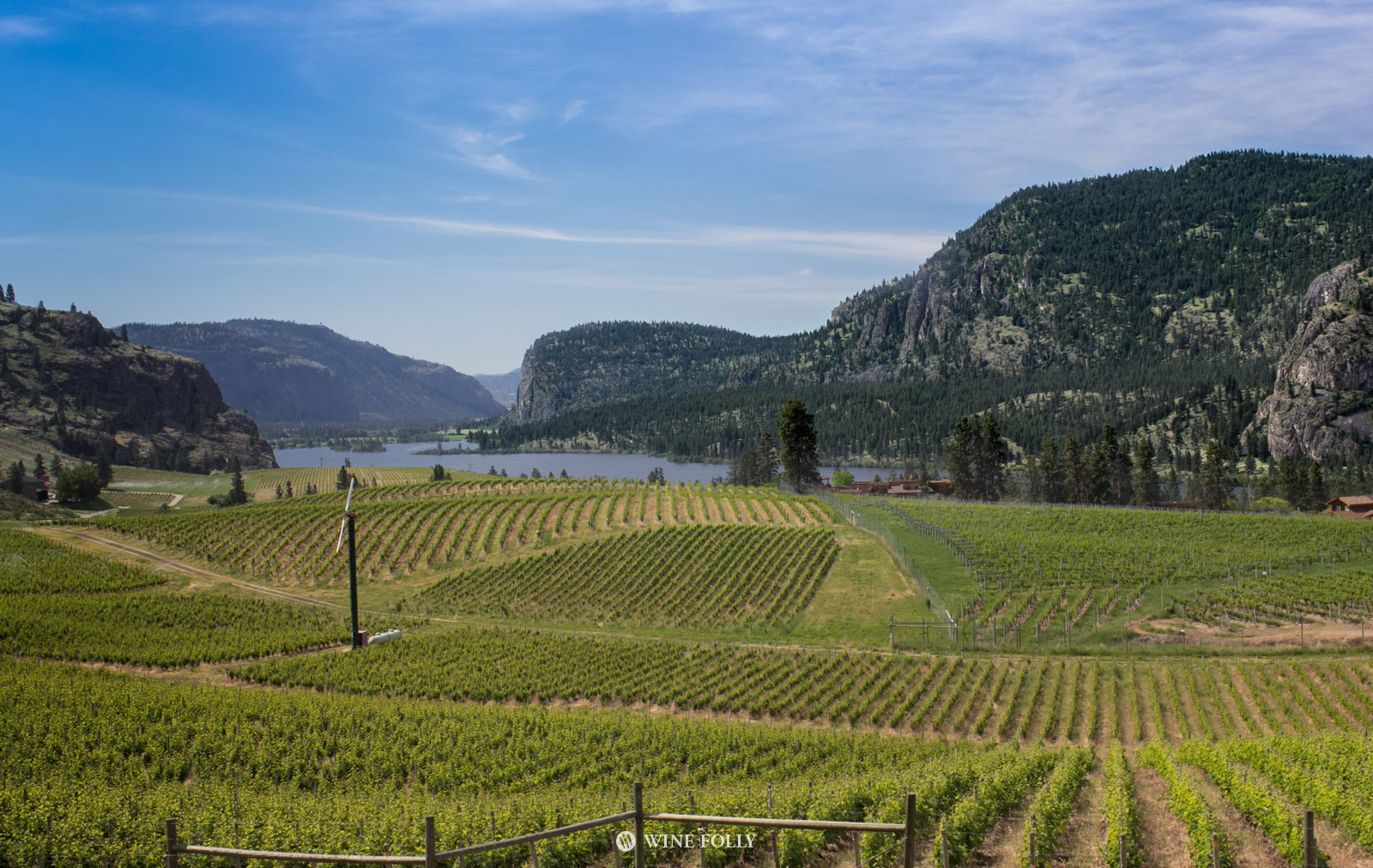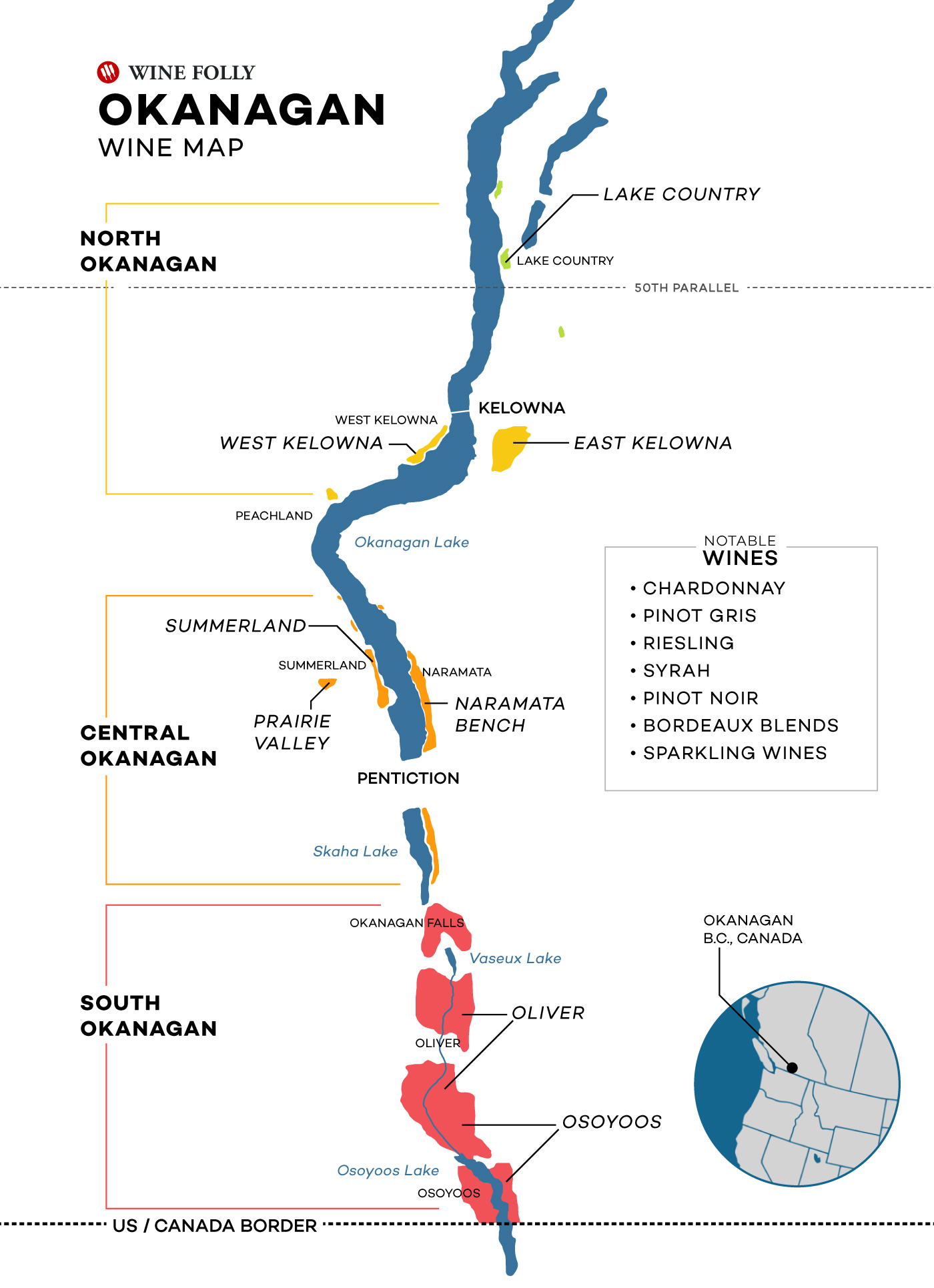This guide to Okanagan wine country explores the region’s best wines and where they grow. Plus, for those who visit, a few travel tips for the wine enthusiast.
You’re about to get frustrated.
You’re about to find out about an unbelievable wine region that you can’t taste unless you go there.
Why? Well, Okanagan wines don’t travel far from British Columbia. That said, it’s well worth the trip.

Most wine aficionados associate Canadian wine country with ice wine. Indeed, for the most part, they’re right. About two-thirds of the world’s ice wine production occurs in Canada.
Thus, Okanagan has a reputation for being “another ice wine region of Canada.” This couldn’t be further from the truth.
But spend any time tasting through the valley, and you’ll quickly realize there’s more to the story. From crisp, mineral-driven whites to structured, savory reds, the Okanagan defies easy categorization. Its dramatic landscapes, ranging from desert-like hills to cool lakeside benches, create a mosaic of microclimates that support an impressive range of grape varieties and styles.
Okanagan Valley’s best wines are dry red and white wines.
Okanagan’s Sub-GIs: A Sense of Place
In recent years, British Columbia has taken big steps to spotlight the diversity within the Okanagan Valley. Sub-Geographical Indications (sub-GIs) allow producers to label their wines with more precision, highlighting the unique terroirs that define each corner of the valley.
- Golden Mile Bench – 2015
- Okanagan Falls – 2018
- Naramata Bench – 2019
- Skaha Bench – 2019
- Golden Miles Slopes – 2021
- Lake Country – 2022
- South Kelowna Slopes – 2022
- East Kelowna Slopes – 2022
- Summerland Bench – 2022
- Summerland Lakefront – 2022
- Summerland Valleys – 2022
- Black Sage Bench – proposed
- Osoyoos East Bench – proposed
Recognized Okanagan Sub-GIs:
Each sub-GI comes with its own soil types, exposures, and microclimates, giving wine lovers and producers a clearer map of what’s in the bottle.

Okanagan Winemaking
Making wine here is no small feat. Okanagan wine country lies at the outer limits of viticulture. It sits right below the 50th parallel (that’s the same as Champagne, by the way). Yet unlike Champagne, Okanagan is dry, sunny, and hot.
Still, the growing season is relatively short. So, how do they ripen red grapes?
For one, there are long daylight hours in the summer months. (It’s light out well after 9 pm!) Additionally, the 83-mile-long (134 km) Lake Okanagan moderates temperature extremes in both summer and winter.
The best part is that the region has a long history in agriculture. Before this area was known for wine, it was famous for peaches, cherries, and apples. This is important because it indicates a solid agricultural foundation that has evolved with time.
In recent years, the region has faced new challenges and opportunities. Climate events, such as the 2021 heat dome and wildfire seasons, have prompted growers to adopt drought-resistant rootstocks and reassess vineyard orientation and canopy management.
Sustainability is now a hallmark of the region. As a result, a growing number of producers are certifying organic or using regenerative practices to combat climate variability and improve soil health.

The Wines of Okanagan
Syrah
This was a surprise for us. Syrah thrives in warm, sunny climates like South Australia, South Africa, and the Northern Rhône Valley. In Okanagan, you’ll find most of the best wines grow in the South around Oliver and Osoyoos (“oh-soy-yoos”). One notable area for wine production is on the east side of Oliver, on the Black Sage bench.
Okanagan Syrah tastes much closer to what you’ll find in cooler parts of the Northern Rhône. The best examples exhibit flavors of red cherry, dried cranberry, sage, and white pepper. Wines have medium-plus tannins, moderate acidity, and a sweet cherry finish. This is not your typical big, bold Syrah. It’s elegant and often has a slightly meaty aroma.
Bordeaux Blends
More surprises emerge from the Bordeaux blends, which are made with Merlot and Cabernet Franc. While Cabernet Sauvignon seems to have trouble here, Merlot and Cabernet Franc do just fine on the lake’s eastern benches.
The Merlot is reminiscent of what you might find in Bordeaux, but slightly leaner and a little fruitier. Flavors include sweet cherry fruit, black currant, cocoa powder, tobacco, and a minerally, wet gravel note.
Lovers of the Loire will appreciate Okanagan Cabernet Franc for its flavors of dried pepper flakes, cherry sauce, and cocoa powder, along with moderate acidity. However, the wines taste riper and sweeter here, with more robust, suede-like tannins.

Other Reds
Currently, the region is heavily invested in Bordeaux-style red blends. This is undoubtedly due to high demand. However, the future may tell a different story as varieties like Gamay and Zweigelt are gaining ground.
Pinot Noir
Who would think Pinot Noir could grow here? In the north, in East Kelowna, there is a fair amount of powdery, chalk-like soil. The soil is so powdery that it’s unlikely phylloxera will survive here. The Pinot Noir wines from this area will appeal to those who love pure, elegant, fruity reds. Well-made examples offer sweet raspberry, cranberry, and pomegranate notes with high acidity and crunchy, green tannins (from whole cluster fermentation).
Syrah Blends
The areas with granite and volcanic sandy soils in the south and eastern sides of the lake produce red wines with high aromatics. These spots might actually be well-suited for GSM-blends (Grenache-Syrah-Mourvèdre) or multi-faceted CMS blends (Cabernet-Merlot-Syrah) like you might find in Priorat or Eastern Washington.
Okanagan should be known for its outstanding white wines.
Chardonnay
Chardonnay is where Okanagan is starting to take world-class strides. It’s a lot like Chablis, but with the kiss of oak.
In the south, the best plantings are on the west side of the valley to avoid the afternoon sun. These wines offer up aromas of passion fruit, yellow apple, and apricot, with toasty notes of crème brûlée and lemon curd. Most notably, they have remarkable, mouth-watering acidity and rarely taste thick.
Meanwhile, in the north, Chardonnay does wonders in East Kelowna’s chalk-like soil. Wines are often quite lean, with aromas of green apple, white blossoms, gun flint, and pine needle. Expect sky-high acidity, balanced with subtle notes of lanolin and hazelnut, from aging in neutral oak puncheons.
Riesling
Riesling from the Okanagan could definitely be better known. The style is much drier than most, allowing Riesling to sit alongside other more popular dry white wines, such as Pinot Grigio and Sauvignon Blanc. Some of the best sites for this grape are in East Kelowna or the south, from sheltered vineyards on the west side.
In terms of flavor, think kiwis, limes, and leesy richness in your glass of Okanagan Riesling. If seeking a comparison, look to Grosse Gewaches (dry German Riesling) from the Rheingau. Or, maybe even a Grand Cru Riesling from Alsace, France.
Pinot Gris
Pinot Gris is a standby in the Okanagan. It’s hard to do wrong with this grape. The best examples are among the most aromatically expressive Pinot Gris available. Flavors are rich with honeysuckle, orange blossom, and peach, with sky-high acidity, and a lean, tingly finish.
Other Whites
Although most enthusiasts opt for red wines, the Okanagan should be known for its outstanding white and sparkling wines. The region consistently hits all the marks, including high acidity, fruitiness, and floral aromatics.
Sparkling Wines
Given that the growing season is so short, many growers pick grapes with low pH (high acidity) and produce sparkling wines. The sparkling wines from Okanagan have fantastic potential, with the ability to age 15+ years (when well-made) and develop subtle hazelnut-cream notes.
Sauvignon Blanc
Another bombshell. The best examples tend to be from vineyards protected from the afternoon sun. Wines have bold aromas of passion fruit and pasilla pepper, with high acidity and a long, tingly finish.
Viognier
Where Viognier from Paso Robles and the Northern Rhône is oily and rich with flavors of tangerine and vanilla, Okanagan Viognier is lean and minerally. Imagine flavors of key lime, honeysuckle, honeydew melon, and crushed rocks, supported by tangy, candy-like acidity.
Aromatic Varieties
They may not be popular, but aromatic whites, including Muscat and Gewürztraminer, are perfectly at home in the Okanagan. If someone figures out how to make a great, semi-bubbly Moscato here, it will take off!

When You Go to Okanagan Wine Country
What’s surprising about Okanagan is that not only is it stunningly beautiful, it’s also shockingly affordable. As a wine country destination, the Okanagan remains largely undiscovered. Here are some things to expect when you go.
- Wine tastings run around $10–$20 Canadian ($7–$13 USD!), but some waive the fee if you buy a bottle.
- The majority of Okanagan’s 12,000 vineyard acres are right across the US border around Osoyoos and Oliver.
- The area is very seasonal. It’s snowy in the winter with very little tourist traffic, and it’s jam-packed (and hot) in the summer.
- Late spring and early fall are the ideal times to visit for a wine enthusiast (the best way to avoid seasonal traffic).
- Many wineries offer virtual tastings, wine subscriptions, and online ordering — a legacy of the pandemic that’s stuck around due to strong demand.
- Beyond wine, the region has amazing hiking, backpacking, cycling, skiing, water sports, and camping.
- In terms of quality, some wineries are outstanding, while many are just average. Be sure to do your research.
- Whatever you do, make sure you bring something to keep your bottles cool.
- It’s windy at night and there are lots of mosquitoes by the lake, so be prepared!

Okanagan Terroir
For those who like to talk dirt….
The Okanagan Valley was once a massive glacier. The soils are primarily sandy, with white clay-silt on top of gravelly glacial sands, and contain limestone, granite, and other gravels of ancient volcanic origin.
What does that actually mean? Well, if you were to sum them up, wines produced on these soils generally have expressive aromatics, minerality, and more subtle tannins.
The region’s location, just south of the 50th parallel, means it has a short growing season. Grapes rapidly develop sweetness during the day, but it’s cold at night. This is a classic example of diurnal shift and is one of the reasons why Okanagan wines have mouth-zapping acidity.
Even so, ripeness levels can still get out of hand; we noticed volatile acidity in some winery programs.

As far as winemaking and viticulture go, the Okanagan is still being explored. Fortunately, Canada has a history of welcoming winemakers from all over, including places like New Zealand, South Africa, Australia, and France. The outside talent brings perspective, and wine quality improves with each vintage.
For those moving towards organic and biodynamic wines, this area has good potential. The high winds, lack of phylloxera, and extreme seasons deter a lot of pests.
One clever technique commonly employed in Okanagan wine country is picking grapes at multiple points throughout harvest. Then, they’re blended to create a single, more balanced wine. Wines made with this method display both ripe flavors and high natural acidity.

Another common practice in the Okanagan Valley is the use of larger oak puncheons. This might be a traditional choice (based on economics) or because the wines tend to be more elegant and do not require as much oak. Many producers also use American oak for their red wines.
One last quirk about the area is that it is nearly impossible to guesstimate the age of a vineyard. Severe winters periodically kill the vines down to the root. The vines usually survive, but must grow a new trunk. Thus, you won’t see too many gnarly vines (even if they genuinely are old).
